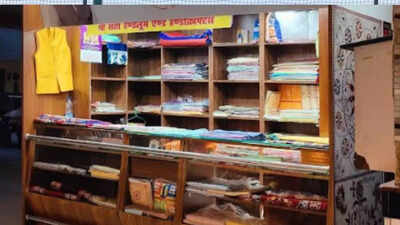- News
- City News
- kolkata News
- OSOP gives new lease of life for local artisans and small entrepreneurs of Bengal
Trending Topics
OSOP gives new lease of life for local artisans and small entrepreneurs of Bengal

KOLKATA: The One-Station-One-Product (OSOP) stall "Bonny’s Creations" at Nangi station in Eastern Railway helped the proprietor Barnali Chakraborty to increase her sales for her organization by more than 50% than earlier.
Pinky Haldar, who is running an OSOP stall at Jadavpur station for selling textile jewellery recorded an average monthly sale of Rs.60,000 with which she managed to have a comfortable life. OSOP also succeeded in showcasing the weaving tales & traditions of the master weaver Biren Kumar Basak and exhibited his 12-yard saga to the common people in a grand way.
In Eastern Railway 57 OSOP stalls are now operating with great enthusiasm and success at different stations in four divisions – Howrah, Sealdah, Asansol, and Malda. Out of these, 21 stalls in Howrah Division, 7 in Malda Division, 7 in Asansol Division & 22 in Sealdah Division. The Products in these OSOP stalls are widely varied envisaging Taant Handloom Saree, Handloom Saree, Cotton Textiles, Pottery, Terracotta products, Silk handloom sarees, Clay products, Cane & Bamboo Products, Brush & metal products, embroidery soft toys, tea leaves, artificial jewellery, Conshell artefacts, papercrafts, dry flowers and decorative products.
ER has already identified 380 stations for establishing OSOP stalls which are in different locations from highly urbanized areas to rural to add flavours of a wide range of products in the product mix, providing opportunities for marketing indigenous products at the doorsteps of the small entrepreneurs & artisans. Eventually, Railway stations are visited by thousands of passengers from every corner of the country and also by foreign tourists frequently. Even a highly localized products of West Bengal, Bihar & Jharkhand in the Eastern Railway network are now getting a scope of global marketing for the indigenous products.
Kausik Mitra, CPRO, Eastern Railway said, “The OSOP scheme has certainly succeeded to provide new livelihood and skill development opportunities to local artisans, potters, handloom weavers, tribals & help local business and supply chain and to exhibit their exquisite products to the world.”
Ministry of Railways launched OSOP scheme with the objective to promote unique local product following the ‘Vocal for Local’ vision of the Government of India. The scheme provides a market for local/indigenous products and creates additional income opportunities for the marginalised sections of society.
Under the scheme, OSOP outlets at railway stations are allotted for showcasing, selling and giving high visibility to indigenous or local products. The pilot of the scheme was started on March 25, 2022 and as on May 1.2023, 728 stations have 785 OSOP outlets in 21 States and 3 Union Territories across the country. These OSOP stalls are designed through National Design Institute for uniformity. So far 25,109 people were directly benefitted from the scheme.
‘One Station One Product’ is specific to that place and includes artefacts made by indigenous tribes, handlooms by local weavers, handicrafts like world-famous wood carving, chikankari and zari-zardozi work on clothes, or spices tea, coffee and other processed or semi-processed food items/products indigenously grown in the area, as for example, Taant sarees of West Bengal, Bhagalpur Silk sarees, Terracotta Products, Bamboo products and jute products.
Product categories, under this scheme, include the following:
1. Handicrafts/ Artefacts
2. Textiles and Handlooms
3. Traditional Garments
4. Local agricultural produce (including Millets)/ Processed/semi-processed foods.
The OSOP appears to be an employment generator turning the lives of many artisans & leading the per capita income even at its best level of society. The subsidence wage earners thus get a chance for a better living and educate their children providing even luxury goods to their family members, which in turn influences the business cycle resulting in more frequent rotation of both money and products in the economy boosting the economy further.
Pinky Haldar, who is running an OSOP stall at Jadavpur station for selling textile jewellery recorded an average monthly sale of Rs.60,000 with which she managed to have a comfortable life. OSOP also succeeded in showcasing the weaving tales & traditions of the master weaver Biren Kumar Basak and exhibited his 12-yard saga to the common people in a grand way.
In Eastern Railway 57 OSOP stalls are now operating with great enthusiasm and success at different stations in four divisions – Howrah, Sealdah, Asansol, and Malda. Out of these, 21 stalls in Howrah Division, 7 in Malda Division, 7 in Asansol Division & 22 in Sealdah Division. The Products in these OSOP stalls are widely varied envisaging Taant Handloom Saree, Handloom Saree, Cotton Textiles, Pottery, Terracotta products, Silk handloom sarees, Clay products, Cane & Bamboo Products, Brush & metal products, embroidery soft toys, tea leaves, artificial jewellery, Conshell artefacts, papercrafts, dry flowers and decorative products.
ER has already identified 380 stations for establishing OSOP stalls which are in different locations from highly urbanized areas to rural to add flavours of a wide range of products in the product mix, providing opportunities for marketing indigenous products at the doorsteps of the small entrepreneurs & artisans. Eventually, Railway stations are visited by thousands of passengers from every corner of the country and also by foreign tourists frequently. Even a highly localized products of West Bengal, Bihar & Jharkhand in the Eastern Railway network are now getting a scope of global marketing for the indigenous products.
Kausik Mitra, CPRO, Eastern Railway said, “The OSOP scheme has certainly succeeded to provide new livelihood and skill development opportunities to local artisans, potters, handloom weavers, tribals & help local business and supply chain and to exhibit their exquisite products to the world.”
Ministry of Railways launched OSOP scheme with the objective to promote unique local product following the ‘Vocal for Local’ vision of the Government of India. The scheme provides a market for local/indigenous products and creates additional income opportunities for the marginalised sections of society.
Under the scheme, OSOP outlets at railway stations are allotted for showcasing, selling and giving high visibility to indigenous or local products. The pilot of the scheme was started on March 25, 2022 and as on May 1.2023, 728 stations have 785 OSOP outlets in 21 States and 3 Union Territories across the country. These OSOP stalls are designed through National Design Institute for uniformity. So far 25,109 people were directly benefitted from the scheme.
‘One Station One Product’ is specific to that place and includes artefacts made by indigenous tribes, handlooms by local weavers, handicrafts like world-famous wood carving, chikankari and zari-zardozi work on clothes, or spices tea, coffee and other processed or semi-processed food items/products indigenously grown in the area, as for example, Taant sarees of West Bengal, Bhagalpur Silk sarees, Terracotta Products, Bamboo products and jute products.
Product categories, under this scheme, include the following:
1. Handicrafts/ Artefacts
2. Textiles and Handlooms
3. Traditional Garments
4. Local agricultural produce (including Millets)/ Processed/semi-processed foods.
The OSOP appears to be an employment generator turning the lives of many artisans & leading the per capita income even at its best level of society. The subsidence wage earners thus get a chance for a better living and educate their children providing even luxury goods to their family members, which in turn influences the business cycle resulting in more frequent rotation of both money and products in the economy boosting the economy further.
Start a Conversation
FOLLOW US ON SOCIAL MEDIA
FacebookTwitterInstagramKOO APPYOUTUBE










